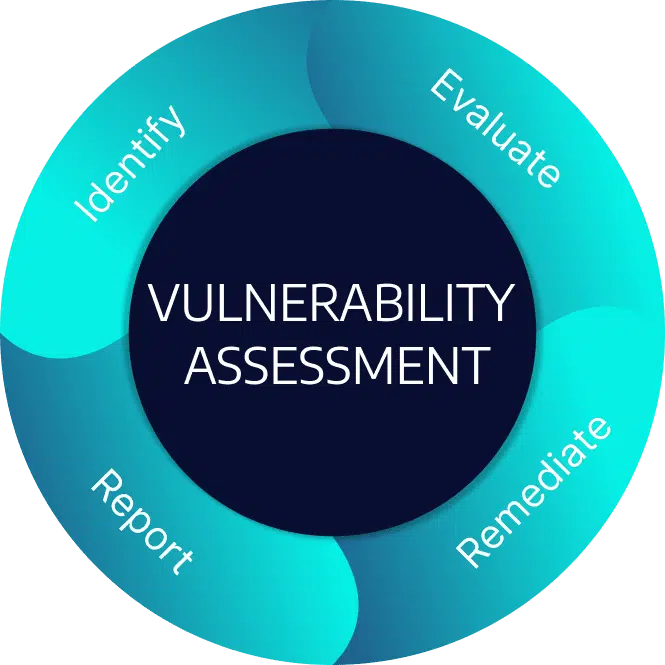What Is Vulnerability Management?
Vulnerability management involves identifying, analyzing, triaging, and resolving security weaknesses. This end-to—end process handles the entire lifecycle of vulnerabilities to cover as many attack vectors as possible.
Modern IT infrastructure incorporates many components, including operating systems, databases, applications, firewalls, and orchestration tools, creating a large attack surface of potential vulnerabilities. As a result, manually analyzing the security posture is no longer feasible.
Since the security landscape is highly dynamic, with many threats and attacks introduced daily, vulnerability management must become a constant process. Vulnerability management tools automate this process to ensure all of these different components of the modern IT environment are continuously configured to minimize potential threats.
In this article:
- Why Is Vulnerability Management Important?
- What Is Considered a Vulnerability?
- Security Vulnerabilities Examples
- The Vulnerability Management Lifecycle
- What Are Vulnerability Management Tools?
- Vulnerability Management Best Practices
- Vulnerability Management with Bright Security
Why Is Vulnerability Management Important?
Effective vulnerability management can help organizations avoid data breaches and leaks. This process involves continuously conducting vulnerability assessments. A vulnerability assessment involves identifying, evaluating, classifying, remediating, and reporting vulnerabilities in enterprise applications, end—user applications, browsers, and operating systems.

Organizations may discover thousands of new vulnerabilities yearly, which require patching operating systems and applications and reconfiguring network security settings. However, organizations that do not have a robust patch management program usually fail to apply patches in time.
A typical corporate network can contain thousands of vulnerabilities, and it is impossible to keep them all patched. However, a vulnerability management plan helps organizations address the most severe vulnerabilities. It provides a process and tools to constantly identify and remediate the most critical vulnerabilities.
Learn more in our detailed guide to vulnerability testing.
What Is Considered a Vulnerability?
A vulnerability is any security weakness within a network, infrastructure, or other system that can potentially allow external threat actors to gain unauthorized control or access to an application, endpoint, service, or server.
Common software vulnerabilities include:
- Lack of authorization and data encryption.
- Insufficient authentication for critical functions.
- Operating system command injection.
- Buffer overflow.
- Unrestricted upload of suspicious file types.
Each security vendor may utilize unique vulnerability and risk mitigation definitions. However, vulnerability management is generally considered an open, standards—based effort that involves using the security content automation protocol (SCAP). Here are the four components of SCAP:
- Common vulnerabilities and exposures (CVE)—a CVE represents a certain vulnerability that can potentially allow a cyberattack to occur. Learn more in our guide to CVE vulnerabilities.
- Common configuration enumeration (CCE)—this list includes system security configuration issues to help guide configuration.
- Common platform enumeration (CPE)—each CPE is a standardized method for defining classes of operating systems, devices, and applications within an environment. CPEs help describe what a CCE or CVE applies to. These are the vulnerable endpoints.
- Common vulnerability scoring system (CVSS)—this framework assigns severity scores to each vulnerability. Organizations use CVSS scores to prioritize remediation efforts. CVSS scores can range from zero to ten (represents the most severe risk).
Security Vulnerabilities Examples
Here are some of the main vulnerabilities affecting applications and IT systems.
Source Code Vulnerabilities
Vulnerabilities often emerge in the code during the software development process. These may include logical errors resulting in security weakness—for instance, setting up access privilege lifecycles that attackers can hijack.
Other source code vulnerabilities may result in applications transferring unencrypted sensitive data or using insufficiently randomized strings to encrypt data. Often, when there is a long software development lifecycle, there can be gaps due to the complexity of several developers working together on a project. The testing stage should identify and patch these vulnerabilities, but sometimes they continue to the production environment and damage the organization.
Here are some of the main vulnerabilities affecting applications and IT systems.
Misconfiguration Issues
Misconfiguration errors are a major challenge in setting up an enterprise IT system. For instance, the admin could fail to adjust the software component configurations from the defaults, leaving the system vulnerable. A misconfigured cloud system, Wi—Fi environment, or corporate network could significantly increase the risk to an organization.
It is essential to take the time to properly set up systems and ensure access controls to restrict external devices on the network. Misconfiguration vulnerabilities are usually easy to address. They often result from overburdening the IT team, so involving extra personnel or a managed service provider can help reduce the risk of misconfigurations.
Trust Configuration Vulnerabilities
A trust configuration is a setup that allows data exchanges between hardware and software systems. For instance, a configuration might allow mounted hard disks to read sensitive information from computing clients without requiring additional privileges. Trust relationships often exist between account records and active directories, enabling unfiltered data flows between unmonitored systems.
When attackers gain access to a vulnerable system, they often exploit vulnerable trust relationships to escalate the attack from the initially compromised system to the whole organization’s environment.
Injection Vulnerabilities
Web applications are often vulnerable to injection attacks, especially if they lack adequate configurations. Suppose an application receives user input via online forms and inserts it into a command, database, or system call on the back end. This setup would expose the application to SQL, LDAP, or XML injection attacks.
Injection vulnerabilities allow attackers to exploit a backdoor in the web application’s data flow to redirect user—supplied data or inject malicious commands. Once in the system, the attacker’s code can force the application to display, update, or delete data without user consent. These are common sources of data breaches.
Business Logic Flaws
A business logic flaw is a design or implementation vulnerability in a software application. It has a legitimate function, but attackers can exploit it to perform unauthorized actions. Business logic flaws are often the result of an application that cannot identify and address unexpected user actions.
Most applications use specified constraints and rules to implement business logic. The business team defines these rules and workflows at the business planning or design stage, while developers incorporate them into the applications.
The business logic defines how an application behaves, but it often has a weak point in implementing correct access permissions throughout the user workflow. Business logic flaws occur when the app doesn’t correctly handle user inputs or pass parameters to APIs and functions.
Learn more in our detailed guides about:
- Application Security
- Business logic vulnerabilities
- Vulnerability examples (coming soon)
The Vulnerability Management Lifecycle
Identifying Vulnerabilities
The first step in the vulnerability management process is identifying all the vulnerabilities in the environment. A vulnerability scanner achieves this by scanning all accessible systems, including desktops, laptops, servers, databases, switches, firewalls, and printers.
After scanning all systems, the tool identifies open ports and services running on these systems, logs in to these systems, gathers detailed information, and then correlates this information with known vulnerabilities. These insights can helps create reports, dashboards, and metrics for various audiences.
Evaluating Vulnerabilities
After identifying all vulnerabilities in the environment, you need to evaluate them so you can remediate according to each vulnerability’s risk level, as defined by the organization’s risk management strategy.
Each vulnerability management scanner uses different risk ratings and scores. However, the most commonly referenced framework is the common vulnerability scoring system (CVSS). Vulnerability scores help organizations prioritize the identified vulnerabilities.
While vulnerability scanners are often accurate, they can generate false positives in rare instances. To form an accurate understanding of a vulnerability’s risk, it is important to consider additional factors.
Treating Vulnerabilities
After prioritizing the identified vulnerabilities, you need to remediate them promptly. Ideally, the security team or staff should guide the process of determining treatment strategies in collaboration with system owners and administrators.
This collaborative effort can help accurately determine the relevant remediation approach. After completing the remediation process, the team should run another vulnerability scan to ensure the vulnerability has truly been effectively remediated.
Reporting Vulnerabilities
To ensure timely risk management, it is critical to constantly improve the speed and accuracy of the vulnerability detection process. It requires continually assessing the efficacy of your vulnerability management program by utilizing visual reporting capabilities provided by vulnerability management solutions.
Reporting insights enable teams to determine the appropriate remediation techniques to fix the prioritized vulnerabilities. Security teams can use reporting to monitor vulnerability trends over time and communicate risk reduction progress to leadership.
Advanced solutions offer integrations with patching tools and IT ticketing systems to help easily share information. This functionality helps make meaningful progress toward reducing risk and leveraging vulnerability assessments to fulfill compliance and regulatory requirements.
What Are Vulnerability Management Tools?
Vulnerability management tools identify security weaknesses in IT systems and prioritize the most severe vulnerabilities. These tools use a classification system to identify vulnerabilities on a risk spectrum that starts from low to high severity.
Here are key features of vulnerability management tools:
- Vulnerability scanning—involves using automated tools, such as network scanning, configuration scanning, automated penetration testing, and firewall log analysis.
- Identifying vulnerabilities—this feature analyzes the results of scans to identify and report vulnerabilities within the environment.
- Prioritizing vulnerabilities—this process identifies the environment layers and systems affected by each detected vulnerability and provides information about the vulnerability’s impact, root causes, and severity.
- Remediation recommendations—advanced vulnerability management tools can provide instructions to guide vulnerability remediation.
- Vulnerability patching—some vulnerability management tools can automatically respond to issues. For example, the tool can automatically apply a patch to the affected systems or change firewall rules to block the attack vector.
- Vulnerability shielding—sometimes, it may be difficult or even impossible to fix a vulnerability at its source. Advanced solutions use virtual patching or shielding to add controls to prevent exploitation. For instance, if a vulnerability requires threat actors to access a specific file to exploit it, the tool protects access to this file.
Vulnerability Management Best Practices
Here are some best practices to help ensure the success of a vulnerability management program.
Create the Vulnerability Management Plan
There are multiple reasons to create a vulnerability management plan. One major reason is to ensure compliance with security regulations and industry standards like PCI DSS and ISO 27001.
Another important purpose of the vulnerability management plan is to enable full visibility into an organization’s IT infrastructure. It helps businesses respond to security threats quickly and effectively. A poor vulnerability management plan is unlikely to help organizations protect against attacks.
A robust vulnerability management plan should incorporate comprehensive security measures and access controls, considering the following basic elements:
- Personnel—a company’s IT and security teams should have the right experience and skills to implement the plan. They must understand how each vulnerability affects the overall environment. All employees should communicate effectively with other staff and relevant stakeholders.
- Processes—once an organization establishes the vulnerability management plan, it must have a strategy for implementing repeatable, clearly understood processes. An effective vulnerability management plan allows teams to quickly make remediation and mitigation decisions.
- Tools—the organization must identify the right technologies and configurations to implement its vulnerability management plan. It should use tools to collect vulnerability data, analyze risks, and perform automated remediation actions. Additional tools should track all digital assets and databases to identify vulnerabilities continuously.
Each of these elements is important in itself, but combining them in a comprehensive strategy is the greatest advantage. The vulnerability management plan should allow integration between multiple systems to provide full security coverage.
Implement Frequent Scans
Frequent scanning helps identify new vulnerabilities introduced into the network—a constant risk. Discovering and fixing vulnerabilities fast is the key to minimizing the risk of an exploit.
One way to secure the network is to assign the necessary resources for maintaining network security and discovering new security vulnerabilities. The right configuration ensures that all updates and patches are applied immediately and correctly.
Another approach is to use security scanners to test the organization’s existing security configurations, equipment, applications, and processes to identify and fix weaknesses. In addition to reactive measures like intrusion detection systems (IDS), firewalls, and antivirus, businesses should use proactive solutions to address issues in advance.
In other words, fixing existing vulnerabilities is more effective than relying on a strong security perimeter. It helps teams understand vulnerabilities and secure the network and applications.
Establish a Patch Management Strategy
Traditional vulnerability scans generate large volumes of data, making it difficult to address all vulnerabilities without disrupting system operations. The vulnerability management plan should specify a patch management strategy with processes for quickly patching critical assets.
These patch management processes should be part of the overall change management strategy, ensuring that teams apply patches and updates in a controlled, consistent manner.
Implement an Incident Response Plan
The incident response speed is one important aspect of vulnerability management. A faster response reduces the potential impact of security vulnerabilities. The incident response plan should cover more than reacting to breaches—it should include proactive measures to ensure the team is always ready to respond to new threats. Fast incident response requires continuous monitoring, automated processes, and prioritized alerts.
Vulnerability Testing with Bright Security
Bright Security helps address the shortage of security personnel, enabling AppSec teams to provide governance for security testing, and enabling every developer to run their own security tests.
Bright empowers developers to incorporate an automated Dynamic Application Security Testing (DAST), earlier than ever before, into their unit testing process so they can resolve security concerns as part of their agile development process. Bright’s DAST platform integrates into the SDLC fully and seamlessly:
- Test results are provided to the CISO and the security team, providing complete visibility into vulnerabilities found and remediated
- Tickets are automatically opened for developers in their bug tracking system so they can be fixed quickly
- Every security finding is automatically validated, removing false positives and the need for manual validation
Bright Security can scan any target, whether Web Apps, APIs (REST/SOAP/GraphQL) to help enhance DevSecOps and achieve regulatory compliance with our real-time, false positive free actionable reports of vulnerabilities. In addition, our ML-based DAST solution provides an automated solution to identify Business Logic Vulnerabilities.
Learn more about Bright Security testing solutions
See Additional Guides on Key Application Security Topics
Together with our content partners, we have authored in-depth guides on several other topics that can also be useful as you explore the world of application security.
API Security
Authored by Bright Security
- What Is API security? The Complete Guide
- REST API Testing: The Basics and 8 API Testing Tips
- 11 API Security Best Practices You Must Know
CSRF
Authored by Bright Security
- Cross-Site Request Forgery (CSRF): Impact, Examples, and Prevention
- CSRF tokens: What is a CSRF token and how does it work?
- CSRF Attacks: Real Life Attacks and Code Walkthrough
LFI
Authored by Bright Security
- Local File Inclusion: Understanding and Preventing Attacks
- LFI Attack: Real Life Attacks and Attack Examples
- File Inclusion Vulnerabilities: What are they and how do they work?




